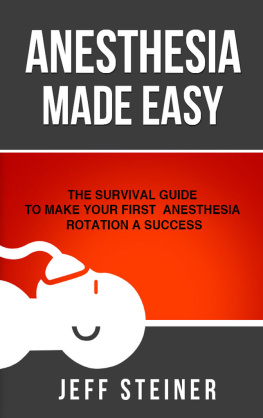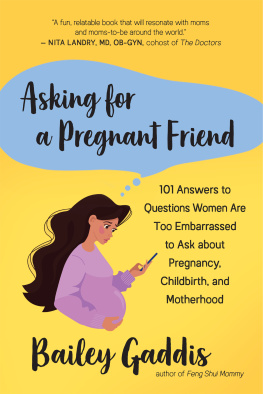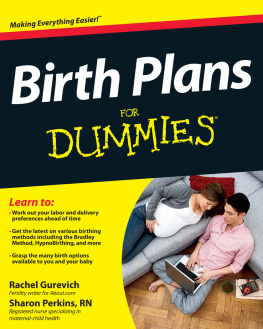The Epidural Book
The
Epidural
Book
A Womans Guide to Anesthesia for Childbirth
Richard Siegenfeld, M.D.

Note to the reader: The information in this book should by no means be considered a substitute for the advice of qualified medical professionals. This book describes anesthesia for childbirth in general. It was not written about your situation. The services of a competent professional should be obtained whenever medical or other specific advice is needed.
All efforts have been made to ensure the accuracy of the information contained in this book as of the date of publication. The author and the publisher expressly disclaim responsibility for any adverse outcomes arising from the use or application of the information contained herein.
2008, 2012 Richard Siegenfeld, M.D.
All rights reserved. Published 2012
Printed in the United States of America on acid-free paper
9 8 7 6 5 4 3 2 1
The Johns Hopkins University Press
2715 North Charles Street
Baltimore, Maryland 21218-4363
www.press.jhu.edu
Library of Congress Cataloging-in-Publication Data
Siegenfeld, Richard.
The epidural book : a womans guide to anesthesia for childbirth / Richard Siegenfeld.
p. cm.
Includes bibliographical references and index.
ISBN 978-1-4214-0733-3 (hdbk. : alk. paper) ISBN 978-1-4214-0734-0 (pbk. : alk. paper) ISBN 978-1-4214-0795-1 (electronic) ISBN 1-4214-0733-7 (hdbk. : alk. paper) ISBN 1-4214-0734-5 (pbk. : alk. paper) ISBN 1-4214-0795-7 (electronic)
1. Peridural anesthesiaPopular works. 2. Anesthesia in obstetricsPopular works. I. Title.
RD85.P4S54 2013
617.964dc23 2012012456
A catalog record for this book is available from the British Library.
Illustrations by the author
Special discounts are available for bulk purchases of this book. For more information, please contact Special Sales at 410-516-6936 or specialsales@press.jhu.edu.
The Johns Hopkins University Press uses environmentally friendly book materials, including recycled text paper that is composed of at least 30 percent post-consumer waste, whenever possible.
To my parents
Thank you
Contents
Chapter 1
How Our Thinking and Practice Have Changed
Chapter 2
How an Epidural Works
Chapter 3
Where, Who, and When
Chapter 4
The Preparation
Chapter 5
The Procedure
Chapter 6
The Imperfect Epidural
Chapter 7
Side Effects
Chapter 8
Uncommon Problems
Chapter 9
Rare Complications
Chapter 10
Conditions Affecting Epidurals and Spinals
Chapter 11
Spinals and Walking Epidurals
Chapter 12
Anesthesia for C-Sections
Chapter 13
After Your Delivery
Chapter 14
Alternatives to Epidurals
Chapter 15
Effects on the Baby
Chapter 16
In a Nutshell
Preface
ARE YOU AFRAID OF experiencing uncontrollable or unrelenting pain during childbirth? Have you heard epidural horror stories from people? Perhaps a friend of a friend experienced an epidural that didnt work, took forever to get in, or was painful. Or maybe youve heard of someone whose request for an epidural was even refused?
You may feel better knowing just how well an epidural or a spinal could relieve your pain. Even so, you may still be concerned about the potential effects of an epidural or a spinal on your baby. And what about the potential risks to you? Maybe you have a back problem, scoliosis, or a discreet lower back tattoo. Do you wonder how that may affect your anesthetic options?
Are you concerned about what will happen to you and what your choices are for anesthesia if you have a planned or an emergency C-section? Are you the type of person who feels better psychologically when you know what is happening to you and what your options are? Do you prefer making informed decisions about your care? Do you appreciate when doctors take the time to explain carefully what they will be doing to you, why, and what to expect in easy-to-understand language, free of medical jargon?

My goal in The Epidural Book is to alleviate fear for any woman who anticipates needing an epidural or a spinal for vaginal childbirth. The book does the same for those wondering about anesthesia for a Cesarean section (C-section). I explain procedures in simple ways and address frequently asked questions. This book greatly differs from other labor pain books in its specific focus on anesthesia for the expectant mother: epidurals, spinals, and general anesthesia. Its also purposely lightheartedto make it more enjoyable to learn what you need to know.

Through many years of performing epidurals for labor and delivery and providing anesthesia for C-sections, I have developed a clear sense of what expectant mothers need to know to feel comfortable with any epidural, spinal, or general anesthetic they may require during childbirth. I have heard nearly every question you can imagine, and I answer the most commonly asked questions and others in the chapters ahead.
Not everyone wants to know everything. Maybe you want to delve into how an epidural is administered but dont want to think about risks, or maybe its the other way around. This book is designed so that almost any chapter can be read on its own. Information in some chapters is most easily understood by reading another chapter, but Ill let you know when thats the case. Even if you dont read every part carefully, you might want to skim the entire book so that you know whats here.

Epidurals and spinals, from your standpoint, are practically the same. There are only a few subtle differences between them. I initially discuss epidurals in detail. Then, later in the book, I highlight the unique aspects of a spinal. As you read about epidurals, its fine to assume that you are also reading about spinals, unless I point out specific differences.
The illustrations in this book are not anatomically correct. They are here solely to convey ideas. The opinions in these pages are based on my years of experience as an anesthesiologist. This book does not substitute for individual discussions you should have with your medical caregivers about procedures, their risks, and their benefits.

This book may not address a particular condition you have, and it does not cover every problem related to anesthesia. Please appreciate that medical procedures and information evolve over time, and that I do not provide an exhaustive explanation of any procedure. For a more complete explanation, talk with your health care provider.
People are afraid of what they dont understand. I hope this book provides you with a better understanding of what you need to know to make informed decisions without fear.
Next page













